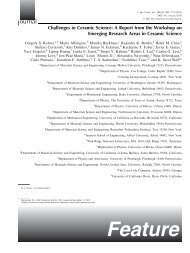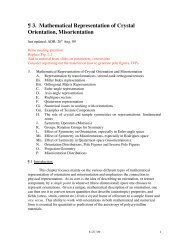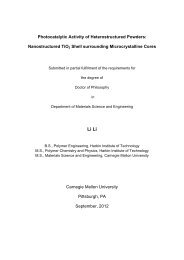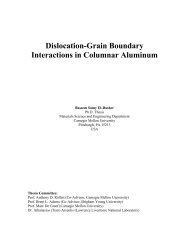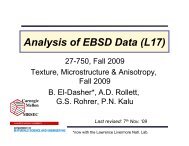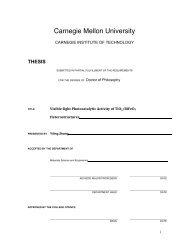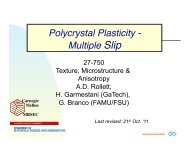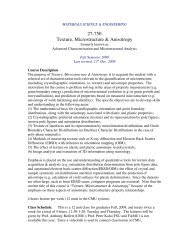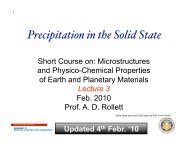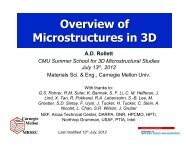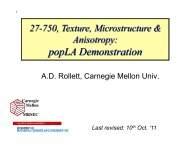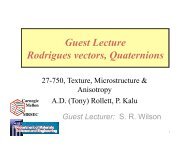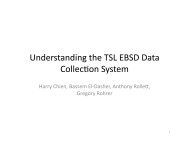Journal of Materials Chemistry PAPER - Materials Science and ...
Journal of Materials Chemistry PAPER - Materials Science and ...
Journal of Materials Chemistry PAPER - Materials Science and ...
You also want an ePaper? Increase the reach of your titles
YUMPU automatically turns print PDFs into web optimized ePapers that Google loves.
<strong>Journal</strong> <strong>of</strong><br />
<strong>Materials</strong> <strong>Chemistry</strong><br />
Cite this: J. Mater. Chem., 2011, 21, 4168<br />
Spatially selective visible light photocatalytic activity <strong>of</strong> TiO 2/BiFeO 3<br />
heterostructures<br />
Yiling Zhang, Andrew M. Schultz, Paul A. Salvador <strong>and</strong> Gregory S. Rohrer*<br />
Received 9th December 2010, Accepted 8th January 2011<br />
DOI: 10.1039/c0jm04313c<br />
Heterostructures <strong>of</strong> thin titania films on BiFeO 3 substrates were grown by pulsed laser deposition. The<br />
heterostructures, when excited by visible light with energies between 2.53 <strong>and</strong> 2.70 eV, photochemically<br />
reduce aqueous silver cations from solution in patterns that mimic the structure <strong>of</strong> the ferroelectric<br />
domains in the substrate. Under the same conditions, titania by itself reduces insignificant amounts <strong>of</strong><br />
silver. The observations indicate that electrons generated in the substrate are influenced by dipolar<br />
fields in the ferroelectric domains <strong>and</strong> transported through the titania film to reduce silver on the<br />
surface.<br />
1 Introduction<br />
Titania is <strong>of</strong> interest for the photovoltaic conversion <strong>of</strong> light to<br />
electricity 1,2 <strong>and</strong> the photocatalytic conversion <strong>of</strong> light to<br />
chemical fuels. 3,4 One <strong>of</strong> the factors that limit the utility <strong>of</strong> titania<br />
for these applications is its b<strong>and</strong> gap. Because the absorption<br />
edges <strong>of</strong> rutile <strong>and</strong> anatase are at about 3.0 eV <strong>and</strong> 3.2 eV,<br />
respectively, they absorb significant amounts <strong>of</strong> light only in the<br />
UV portion <strong>of</strong> the spectrum. 5–7 The majority <strong>of</strong> the energy in the<br />
solar spectrum, on the other h<strong>and</strong>, is carried by photons with<br />
a lower energy. Therefore, titania absorbs only a small portion <strong>of</strong><br />
the available solar energy. This limitation has motivated<br />
attempts to modify the absorption edge <strong>of</strong> titania so that it can<br />
absorb visible light.<br />
One strategy is to substitute a portion <strong>of</strong> the oxygen with<br />
another electronegative atom. For example, N-doped TiO 2<br />
powders <strong>and</strong> films have been shown to absorb visible light 8–15<br />
through electronic states that are approximately 0.75 eV above<br />
the valence b<strong>and</strong> edge <strong>of</strong> pure titania. 12,15 S-doping, 9,13,16–19<br />
C-doping, 9,19–22 <strong>and</strong> F-doping 23 have also been reported to<br />
increase visible light absorption in TiO2. Codoping by S <strong>and</strong> C<br />
have been reported 24 <strong>and</strong> N, C <strong>and</strong> N, F codoped materials have<br />
been reported to exhibit superior visible light activity when<br />
compared to materials doped with a single element. 25,26<br />
A second strategy is to replace a portion <strong>of</strong> the titanium with<br />
another metal atom. Fe is the most commonly used additive<br />
that induces visible light absorption. 27–30 Cr-doping, 27,31 Vdoping,<br />
27,32 Mo-doping, 33 Sb–Cr-codoping, 34 <strong>and</strong> Fe–Ncodoping<br />
35 have also been reported. In general, this doping<br />
increases the photocatalytic activity <strong>of</strong> TiO 2 in the 400–600 nm<br />
range. As with doping on the anion site, it is frequently reported<br />
Department <strong>of</strong> <strong>Materials</strong> <strong>Science</strong> <strong>and</strong> Engineering, Carnegie Mellon<br />
University, Pittsburgh, PA, USA. E-mail: gr20@<strong>and</strong>rew.cmu.edu; Fax:<br />
+1 412 268 7596; Tel: +1 412 268 2696<br />
Dynamic Article LinksC <<br />
www.rsc.org/materials <strong>PAPER</strong><br />
that the substitutional elements create new electronic levels<br />
within titania’s b<strong>and</strong> gap, thereby increasing visible light<br />
absorption. However, the introduction <strong>of</strong> substitutional elements<br />
also creates scattering centers <strong>and</strong> this can cause a decrease in the<br />
photochemical activity. For example, it has been reported that<br />
substitutional Fe serves as a center for charge carrier recombination.<br />
29,36<br />
Another way to increase the visible light activity <strong>of</strong> titania is<br />
through the addition <strong>of</strong> an adsorbed molecular species that can<br />
absorb visible light <strong>and</strong> donate an electron or hole to the titania.<br />
There is an extensive literature on the use <strong>of</strong> organic dyes for this<br />
purpose. 1,2,36 It is also possible to use inorganic ions, such as<br />
Ce 3+ /Ce 4+ , to shuttle electrons <strong>and</strong> holes to <strong>and</strong> from titania. 37,38<br />
It has recently been reported that titania supported on a visible<br />
light absorbing core <strong>of</strong> FeTiO 3 shows enhanced visible light<br />
photoactivity. 39 This particular scheme for inducing visible light<br />
activity in titania has the advantage <strong>of</strong> presenting a pure,<br />
undoped titania surface at a solid–liquid interface that is not<br />
covered by extrinsic adsorbates. The present work takes this<br />
approach to inducing visible light activity in titania, but uses<br />
a ferroelectric substrate (BiFeO3) that also has internal dipolar<br />
fields that will separate charge carriers <strong>and</strong> may reduce recombination.<br />
BiFeO 3 is a semiconductor with a relatively narrow b<strong>and</strong> gap<br />
<strong>of</strong> about 2.5 eV. 40–42 It has also been reported to be photocatalytically<br />
active in visible light. 43,44 Of importance for the<br />
present study, it is ferroelectric with spontaneous polarization<br />
along the pseudo-cubic directions <strong>of</strong> 6.1 mC cm 2 . 45<br />
Spontaneous polarization in the ferroelectric domains leads to<br />
b<strong>and</strong> bending that transports photogenerated electrons <strong>and</strong> holes<br />
in opposite directions 46–48 <strong>and</strong> this can lead to spatially resolved<br />
reactivity. 49–51 Because the photogenerated carriers are separated<br />
by the internal polarization, they are less likely to recombine <strong>and</strong><br />
this may enhance photocatalytic efficiency. It has recently been<br />
shown that charge separation occurs within titania/BaTiO 3<br />
4168 | J. Mater. Chem., 2011, 21, 4168–4174 This journal is ª The Royal Society <strong>of</strong> <strong>Chemistry</strong> 2011
heterostructures when illuminated by UV light. 49,52–54 The separation<br />
<strong>of</strong> carriers leads to the separation <strong>of</strong> the reduction <strong>and</strong><br />
oxidation half reactions so that the back reaction <strong>of</strong> intermediates<br />
is also suppressed. Similar effects have been observed for<br />
BiFeO3 illuminated by UV light. 55<br />
The purpose <strong>of</strong> this paper is to show that titania can be made<br />
photochemically active in visible light with a wavelength <strong>of</strong><br />
460 nm by supporting it on a BiFeO3 substrate. This is demonstrated<br />
by the reduction <strong>of</strong> aqueous silver cations to silver metal.<br />
Furthermore, the reduction reaction is spatially selective <strong>and</strong><br />
correlated to the domains in the BiFeO 3 substrate. The reactivity<br />
<strong>of</strong> the titania film decreases as the film thickness increases. When<br />
titania is not supported by BiFeO 3, illumination by the 460 nm<br />
source yields an amount <strong>of</strong> photochemically reduced silver that is<br />
not significant. Based on these observations, it is concluded that<br />
electrons generated in the BiFeO3 travel through the titania film<br />
to participate in reactions at the solid–liquid interface.<br />
2 Experimental details<br />
Polycrystalline samples <strong>of</strong> BiFeO 3 were synthesized from Bi 2O 3<br />
(Alfa Aesar 99.99%) <strong>and</strong> Fe 2O 3 (Alfa Aesar 99.945%) powders.<br />
Stoichiometric mixtures <strong>of</strong> Bi2O3 <strong>and</strong> Fe2O3 were ball milled in<br />
ethanol for 18–24 h <strong>and</strong> then dried at 85 C. The dried powders<br />
were placed in an alumina crucible <strong>and</strong> calcined at 700 C for 3 h<br />
in air. The powder was again ball milled in ethanol for 24 h,<br />
dried, <strong>and</strong> uniaxially compressed in a cylindrical dye with a load<br />
<strong>of</strong> 105 MPa to form samples approximately 1 cm in diameter <strong>and</strong><br />
3 mm thick. The pellets were sintered at 850 C for 3 h. After this<br />
procedure, X-ray diffraction indicated that the majority phase<br />
was BiFeO 3. Small amounts <strong>of</strong> Bi 2Fe 4O 9, Bi 25FeO 40, <strong>and</strong> Fe 2O 3<br />
were also detected in the diffraction pattern <strong>and</strong> will be referred<br />
to collectively in the remainder <strong>of</strong> the manuscript as minority<br />
phases. To prepare the surfaces for analysis, the sintered pellets<br />
were lapped flat with an aqueous Al2O3 suspension (9 mm or<br />
3 mm, Logitech) <strong>and</strong> then polished with a 0.02 mm colloidal SiO2<br />
suspension (Mastermet 2, Buehler) using a Logitech polisher.<br />
The polished pellets were thermally etched at 600 C for 3 h to<br />
repair the polishing damage. For two control experiments,<br />
similar procedures, described previously, were used to prepare<br />
polycrystalline BaTiO3 51 <strong>and</strong> TiO2. 56<br />
Pulsed laser deposition (PLD) was used to deposit TiO 2 films<br />
on BiFeO 3, BaTiO 3, <strong>and</strong> single crystal SrTiO 3 (100) (MTI<br />
Corporation, USA). The TiO 2 target was prepared by compressing<br />
TiO 2 powder uniaxially in a cylindrical dye under a load<br />
<strong>of</strong> 75 MPa to form a disc shaped sample with a diameter <strong>of</strong><br />
approximately 2.5 cm. The target was then sintered in an alumina<br />
crucible at 1400 C for 12 h. For one <strong>of</strong> the control experiments,<br />
an Fe-doped titania target (2 at% Fe) was prepared using the<br />
same procedure, but adding the appropriate amount <strong>of</strong> Fe2O3 as<br />
an iron source. A KrF (l ¼ 248 nm) laser was pulsed at 3 Hz with<br />
an energy density <strong>of</strong> 2 J cm 2 . The target-to-substrate distance<br />
was maintained 6 cm during the growth <strong>of</strong> all films. A base<br />
pressure <strong>of</strong> 10 5 Torr was established in the chamber with the<br />
sample at 120 C. The sample was then heated to a nominal<br />
temperature <strong>of</strong> 500 to 700 C at a rate <strong>of</strong> 25 C min 1 . Because the<br />
surface <strong>of</strong> the substrate is lower than the nominal temperature,<br />
<strong>and</strong> depends on thermal conductivity through the sample, films<br />
on thin substrates were grown at 500 C <strong>and</strong> films on thicker ones<br />
were grown at 700 C. A flow <strong>of</strong> O 2 was maintained at 5 mTorr<br />
during heating <strong>and</strong> deposition. After heating, the TiO 2 target<br />
surface was cleaned by laser ablation at 3 Hz for 10 min. To<br />
determine the deposition rate, a TiO2 film was deposited on<br />
a LaAlO3 single crystal using 3000 laser pulses. The thickness <strong>of</strong><br />
TiO2 film was then measured by X-ray reflectivity <strong>and</strong> the rate<br />
was determined to be 0.0067 nm per pulse. TiO2 was deposited<br />
using 1500, 3000, <strong>and</strong> 12 000 pulses, to produce films with estimated<br />
thicknesses <strong>of</strong> 10, 20, <strong>and</strong> 80 nm, respectively. After<br />
deposition, the samples were cooled in a static atmosphere <strong>of</strong><br />
5 Torr O 2 at a rate <strong>of</strong> 25 C min 1 . Consistent with a recent study<br />
<strong>of</strong> titania films on BaTiO 3, 57 electron backscatter diffraction<br />
measurements indicate that both rutile <strong>and</strong> anatase are grown,<br />
that different grains promote the growth <strong>of</strong> films with different<br />
phases <strong>and</strong> orientations, <strong>and</strong> that the phase <strong>and</strong> orientation are<br />
uniform on each BiFeO3 grain. The use <strong>of</strong> bulk BiFeO3<br />
substrates eliminates the possibility <strong>of</strong> domain orientation<br />
constraints that occur in BiFeO3 thin films <strong>and</strong> superlattices. 58,59<br />
The photochemical reduction <strong>of</strong> silver was used as a marker<br />
reaction to test for photoactivity. The reaction leaves silver<br />
deposits on the surface that can be observed by microscopy. 60,61<br />
For these reactions, a 0.115 M AgNO 3 solution was prepared by<br />
dissolving AgNO 3 in de-ionized H 2O. A viton O-ring was placed<br />
on the sample <strong>and</strong> filled with AgNO 3 solution. A quartz cover<br />
slip was placed on top <strong>of</strong> the O-ring <strong>and</strong> held in place by the<br />
surface tension <strong>of</strong> the liquid. The reaction assembly was brought<br />
as close as possible to a blue LED with an emission energy <strong>of</strong> 2.53<br />
to 2.70 eV (LUXEON, Philips), which was operated at 750 mA<br />
<strong>and</strong> 4.0 V. After illuminating the sample for 60 s, the O-ring <strong>and</strong><br />
the quartz slip were removed, <strong>and</strong> the samples were rinsed by<br />
sequential immersion in two baths <strong>of</strong> de-ionized H2O, <strong>and</strong> then<br />
dried using a stream <strong>of</strong> clean nitrogen. By using energy dispersive<br />
spectroscopy in a scanning electron microscope, it was confirmed<br />
that the reaction product left on the surface contained silver.<br />
X-Ray diffraction <strong>of</strong> a sample illuminated for several hours (to<br />
increase the amount <strong>of</strong> reaction product) confirmed that metallic<br />
silver had been formed, consistent with previous findings. 60,61<br />
Although the oxidation half reaction was not examined in these<br />
experiments, the continuous accumulation <strong>of</strong> silver with longer<br />
illumination indicates that the holes do not accumulate <strong>and</strong> the<br />
eventual appearance <strong>of</strong> macroscopically observable gaseous<br />
bubbles in the silver nitrate solution is consistent with oxygen<br />
production.<br />
Atomic force microscopy (AFM) was used to characterize the<br />
surfaces <strong>of</strong> the samples. Images were recorded using an NTegra<br />
(NT-MDT) microscope or a Dimension 3100 (Veeco) microscope.<br />
Topographic images <strong>of</strong> the surfaces were taken in<br />
conventional semi-contact mode before <strong>and</strong> after Ag + reduction<br />
reactions for comparison. The images were analyzed to estimate<br />
average local Ag thicknesses precipitated on the surfaces.<br />
Piezoresponse force microscopy (PFM) images <strong>of</strong> BiFeO3<br />
substrates were taken before <strong>and</strong> after TiO2 film deposition to<br />
determine the positions <strong>of</strong> the ferroelectric domains.<br />
3 Results<br />
The heterostructures considered here consist <strong>of</strong> either rutile/<br />
BiFeO3 or anatase/BiFeO3. Therefore, we begin by evaluating<br />
the photochemical activity <strong>of</strong> each <strong>of</strong> the three phases by<br />
This journal is ª The Royal Society <strong>of</strong> <strong>Chemistry</strong> 2011 J. Mater. Chem., 2011, 21, 4168–4174 | 4169
Fig. 1 AFM topographic images <strong>of</strong> surfaces <strong>of</strong> (a) bare BiFeO3 before<br />
reaction, (b) BiFeO 3 after reaction, (c) bare rutile TiO 2 before reaction,<br />
(d) rutile TiO2 after reaction, (e) 20 nm anatase TiO2 film on SrTiO3 (100)<br />
before reaction, (f) 20 nm anatase TiO 2 film on SrTiO 3 (100) after reaction.<br />
The topographic contrast in all images is 100 nm from bright to<br />
dark.<br />
themselves. The AFM images in Fig. 1 show the surface <strong>of</strong><br />
BiFeO 3 (a,b), rutile (c,d), <strong>and</strong> anatase (e,f). The BiFeO 3 <strong>and</strong><br />
rutile are bulk ceramic materials. The anatase sample, on the<br />
other h<strong>and</strong>, is a 20 nm film deposited on SrTiO3 (100) under<br />
conditions that produce anatase (001). 62,63 The topographic<br />
contrast in the AFM images arises from a variety <strong>of</strong> sources<br />
including surface steps (S), residual polishing scratches (PS),<br />
boundaries between ferroelectric domains (DB), surface<br />
contamination (SC), <strong>and</strong> inclusions <strong>of</strong> minority phases (MP),<br />
which are labeled on the micrographs. After the photochemical<br />
reaction, the surfaces <strong>of</strong> certain domains in BiFeO 3 are coated<br />
with reduced silver (white contrast). The heights <strong>of</strong> these features<br />
vary between 20 <strong>and</strong> 130 nm. This is the same reaction that has<br />
been observed previously on titania, 56,64 BaTiO 3, 50,51 <strong>and</strong> PZT 65,66<br />
when illuminated by UV light. Here, the reaction is initiated by<br />
visible light. On the titania surfaces, only small changes in the<br />
contrast are found, corresponding either to a small amount <strong>of</strong><br />
silver or surface contamination from immersion in the silver<br />
nitrate solution. Based on these images, it can be concluded that<br />
the BiFeO3 surface reduced far more silver on the active domains<br />
than either <strong>of</strong> the titania surfaces.<br />
The images in Fig. 2 show the correlation between the piezoresponse<br />
<strong>of</strong> the substrate (a) <strong>and</strong> heterostructure (b) <strong>and</strong> the<br />
Fig. 2 (a) PFM phase image <strong>of</strong> bare BiFeO3 surface. (b) PFM phase<br />
image <strong>of</strong> 10 nm TiO2/BiFeO3. (c) Topographic image <strong>of</strong> 10 nm TiO2/<br />
BiFeO3 before reaction. (d) Topographic image <strong>of</strong> 10 nm TiO2/BiFeO3<br />
after reaction. PFM phase contrast scale is 180 to 180 from bright to<br />
dark. Topographic contrast scale is 15 nm from bright to dark.<br />
photochemical reactivity <strong>of</strong> the titania film surface (c <strong>and</strong> d). The<br />
contrast in the piezoresponse force microscopy (PFM) phase<br />
image <strong>of</strong> the BiFeO3 surface reveals the domain structure <strong>of</strong> the<br />
substrate. After depositing a 10 nm titania film, the piezoresponse<br />
<strong>of</strong> the heterostructure is the same. Therefore, the<br />
displacements in the substrate that create the PFM signal are not<br />
significantly affected by the 10 nm titania film. The image in<br />
Fig. 2(c) shows the topography <strong>of</strong> the film surface. Note that<br />
some <strong>of</strong> the components <strong>of</strong> the film topography correlate exactly<br />
with the domain structure revealed by the PFM images. After the<br />
sample is illuminated by blue light in the silver nitrate solution,<br />
new contrast appears on the surface, corresponding to reduced<br />
silver (see Fig. 2(d)). Similar to the reaction on the bare substrate<br />
(Fig. 1(b)), there is more silver reduced on some domains than<br />
others. A typical height for the silver is 100 nm. In this case, the<br />
domains that are dark in the PFM images reduce more silver<br />
than the light contrast domains.<br />
Because the substrate <strong>and</strong> the thin titania film are able to<br />
reduce Ag with visible light, but titania by itself can not, it is<br />
reasonable to assume that as the film increases in thickness, it will<br />
become less reactive. To test this idea, the experiment was<br />
repeated using titania films that were 20 nm <strong>and</strong> 80 nm thick <strong>and</strong><br />
the results are compared in Fig. 3. For each case, one test line is<br />
drawn on the image recorded before the reaction <strong>and</strong> a second is<br />
drawn on the same location after the reaction. The topography<br />
along these two lines is compared in the third panel <strong>of</strong> the figure.<br />
For the 10 nm <strong>and</strong> 20 nm thick films, the maximum heights <strong>of</strong> the<br />
deposited silver are in the range <strong>of</strong> 60 to 100 nm, but for the<br />
80 nm thick titania film, the heights <strong>of</strong> the deposited silver do not<br />
exceed 20 nm. For comparison, the maximum height <strong>of</strong> silver<br />
deposited on the bare BiFeO3 surface under the same conditions<br />
is approximately 130 nm. Therefore, the amount <strong>of</strong> silver<br />
reduced by the titania film decreases with film thickness.<br />
4170 | J. Mater. Chem., 2011, 21, 4168–4174 This journal is ª The Royal Society <strong>of</strong> <strong>Chemistry</strong> 2011
Fig. 3 AFM topographic images <strong>and</strong> height pr<strong>of</strong>iles <strong>of</strong> TiO2/BiFeO3 with TiO2 thickness <strong>of</strong> (a) 10, (b) 20, <strong>and</strong> (c) 80 nm. Each row from left to right<br />
shows the image before reaction, the image after reaction, <strong>and</strong> a comparison <strong>of</strong> the height pr<strong>of</strong>iles at the same locations. The contrast scale from bright to<br />
dark is 100 nm for all images.<br />
Ideally, the only component <strong>of</strong> the heterostructures that can<br />
absorb light <strong>and</strong> create carriers is the substrate. However, based<br />
on previous work, 67 one could hypothesize that Fe contamination<br />
(which could diffuse from the BiFeO 3 substrate during<br />
growth) might increase absorption in the film. While it is<br />
impossible to eliminate contamination from the substrate, it is<br />
possible to grow an Fe-doped titania film on a substrate that does<br />
not absorb visible light, to see if Fe-doping in the film by itself is<br />
sufficient to explain the visible light activity observed in the TiO2/<br />
BiFeO3 heterostructures. The AFM images in Fig. 4 compare the<br />
surface <strong>of</strong> a 10 nm thick Fe-doped titania film on SrTiO3 (100)<br />
before <strong>and</strong> after the reaction. It is clear from the image in<br />
Fig. 4 Topographic images <strong>of</strong> a 10 nm thick Fe-doped-TiO2 film on<br />
SrTiO 3 (100) (a) before reaction <strong>and</strong> (b) after reaction. The contrast scale<br />
from bright to dark is 15 nm. The images are not from the same area, but<br />
are representative <strong>of</strong> all areas that were imaged.<br />
Fig. 4(b) that very little silver is deposited on the Fe-doped titania<br />
film. Therefore, Fe-doping in the titania layer is not sufficient to<br />
explain the reactivity <strong>of</strong> the unintentionally doped titania films<br />
on the BiFeO 3 surface.<br />
It is also feasible that the ferroelectric substrate creates<br />
charged interface states that induce the visible light activity. To<br />
test this idea, a 20 nm titania film was grown on BaTiO3, which is<br />
also ferroelectric, but does not absorb visible light. 68,69 The<br />
results are shown in Fig. 5. The image in Fig. 5(a) shows the<br />
surface <strong>of</strong> the titania film before reaction. The image shows some<br />
weak contrast that arises from the domain structure <strong>of</strong> the<br />
substrate. The image in Fig. 5(b) shows some silver on the<br />
surface. However, the amount <strong>of</strong> deposited silver is much less<br />
Fig. 5 Topographic images <strong>of</strong> a 20 nm TiO 2 film on BaTiO 3 (a) before<br />
reaction <strong>and</strong> (b) after reaction. The contrast scale from bright to dark is<br />
40 nm.<br />
This journal is ª The Royal Society <strong>of</strong> <strong>Chemistry</strong> 2011 J. Mater. Chem., 2011, 21, 4168–4174 | 4171
than on films supported by BiFeO 3 <strong>and</strong> similar to the silver<br />
observed on the surface <strong>of</strong> bulk titania (see Fig. 1). Furthermore,<br />
there is no obvious correlation between the pattern <strong>of</strong> silver <strong>and</strong><br />
the underlying domain structure as observed when the same<br />
structure is illuminated by UV light. 49,53<br />
4 Discussion<br />
The results presented here indicate that the photochemical<br />
reduction <strong>of</strong> silver, initiated by visible light, is spatially selective<br />
on the BiFeO 3 surface. While the amount <strong>of</strong> silver was observed<br />
to vary somewhat with the grain <strong>and</strong> orientation, similar<br />
spatially selective reactivity was found on all grains. Assuming<br />
the spatially selective reactivity is analogous to what occurs in<br />
BaTiO3 <strong>and</strong> PZT, then the reduction reaction is probably associated<br />
with domains that have polarizations pointed away from<br />
the surface, where b<strong>and</strong>s are bent downward <strong>and</strong> electrons move<br />
down the gradient toward the surface. 49–51,66 The main difference<br />
is that for BaTiO3 <strong>and</strong> PZT, the same reaction can only be<br />
initiated by UV light.<br />
Titania is relatively unreactive when illuminated by visible<br />
light. The images <strong>of</strong> bulk rutile (Fig. 1(d)), anatase supported by<br />
SrTiO3 (Fig. 1(f)), <strong>and</strong> titania supported by BaTiO3 (Fig. 5(b))<br />
after illumination suggest that a small amount <strong>of</strong> silver is<br />
reduced, even though the b<strong>and</strong> gaps are larger than the energy <strong>of</strong><br />
illumination. The distribution <strong>of</strong> reaction product is inhomogeneous;<br />
we assume that the carriers responsible for this limited<br />
reaction are generated by absorption <strong>of</strong> light at defect states such<br />
as oxygen vacancies that have states below the conduction b<strong>and</strong><br />
edge. This background reactivity is presumably present in all <strong>of</strong><br />
the experiments, but is overwhelmed by the spatially selective<br />
reactivity <strong>of</strong> the films supported by BiFeO 3.<br />
The observations from the TiO 2/BiFeO 3 heterostructures<br />
indicate that the carriers that react on the titania film surface are<br />
created by absorption in the substrate. This is completely<br />
analogous to the conclusion reached by Burbure et al. 49,53 in<br />
studies <strong>of</strong> thin titania films on BaTiO3 excited by UV radiation.<br />
One observation that supports this conclusion is that when<br />
titania is not supported by BiFeO3, it absorbs very little light <strong>of</strong><br />
this energy <strong>and</strong> does not reduce significant amounts <strong>of</strong> silver. The<br />
second observation is that the patterns <strong>of</strong> silver on the surface<br />
have the same configuration as those in the supporting substrate.<br />
The third supporting observation is that the reactivity <strong>of</strong> the film<br />
decreases as the thickness increases. This all indicates that light<br />
absorbed in the narrower b<strong>and</strong> gap substrate creates electrons<br />
<strong>and</strong> holes that travel through the thin film <strong>and</strong> react on the<br />
surface.<br />
It should be mentioned that a recent study <strong>of</strong> anatase–BiFeO3<br />
nanocomposites demonstrated enhanced visible light activity<br />
compared to titania alone. 67 In that case, the enhancement was<br />
attributed to interdiffusion <strong>of</strong> the metallic components <strong>and</strong>, in<br />
particular, Fe-doping <strong>of</strong> the titania. However, the results shown<br />
in Fig. 4 indicate that Fe-doping in the film is, by itself, not<br />
sufficient to make the films significantly more reactive in the<br />
conditions used here. Another possible explanation is that<br />
multiple reflections <strong>and</strong> scattering at the buried interface between<br />
the ferroelectric <strong>and</strong> the supported film enhance the path length<br />
<strong>of</strong> light in the titania film <strong>and</strong> lead to enhanced absorption.<br />
However, if this were the case, then we would have expected the<br />
same result in the film supported by BaTiO 3; the film supported<br />
by BaTiO 3 is not significantly more reactive in visible light than<br />
bulk titania.<br />
Of the situations examined here, the BiFeO3 substrate had the<br />
highest reactivity <strong>and</strong> the titania films all have lower reactivities.<br />
If the goal were only to have the highest reactivity for silver<br />
reduction, BiFeO3 would be the best choice. However, to be<br />
useful for water photolysis, the material must be stable in<br />
aqueous solutions <strong>and</strong> its conduction b<strong>and</strong> energy must be higher<br />
than the hydrogen reduction level. While these two conditions<br />
are met by titania, they are not met by BiFeO 3.<br />
To underst<strong>and</strong> the mechanism <strong>of</strong> visible light reactivity,<br />
plausible energy level diagrams for the heterostructures (see<br />
Fig. 6) are constructed according to the following principles.<br />
First, BiFeO3 is reported to be a p-type semiconductor 70,71 <strong>and</strong> its<br />
b<strong>and</strong> gap has been reported to be between 2.2 <strong>and</strong> 2.7 eV in<br />
different studies. 40–42 Here, we will assume a value <strong>of</strong> 2.5 eV. The<br />
electron affinity is estimated to be 4.6 eV using the method<br />
described by Morrison. 72 The position <strong>of</strong> the Fermi level is<br />
Fig. 6 Schematics <strong>of</strong> b<strong>and</strong> structure <strong>of</strong> BiFeO3/TiO2/H2O with the<br />
polarization (P S) <strong>of</strong> BiFeO 3 (a) pointing away from BiFeO 3/TiO 2 interface,<br />
<strong>and</strong> (b) pointing towards BiFeO3/TiO2 interface. In the figure, the<br />
vacuum level, conduction b<strong>and</strong> edge, Fermi level <strong>and</strong> valence b<strong>and</strong> edge<br />
are give by the symbols Evac, Ec, Ef, <strong>and</strong> Ev, respectively. The hydrogen,<br />
silver, <strong>and</strong> oxygen redox levels are indicated on the right.<br />
4172 | J. Mater. Chem., 2011, 21, 4168–4174 This journal is ª The Royal Society <strong>of</strong> <strong>Chemistry</strong> 2011
estimated to be 0.5 eV above the top <strong>of</strong> the valence b<strong>and</strong> edge.<br />
Undoped TiO 2 is typically oxygen-deficit <strong>and</strong> thus is considered<br />
n-type with a b<strong>and</strong> gap <strong>of</strong> 3.0 eV (for rutile) 5,6 <strong>and</strong> 3.2 eV (for<br />
anatase). 7 The work function is reported to be 4.2 eV 73 <strong>and</strong> the<br />
Fermi level is approximately 0.2 eV below the bottom <strong>of</strong> the<br />
conduction b<strong>and</strong>. 5 When titania is supported by BiFeO3, a p–n<br />
junction is created. When bulk TiO2 is in contact with the solution,<br />
exchange <strong>of</strong> charge with the solution leads to upward b<strong>and</strong><br />
bending at the interface. However, because the film thickness is<br />
less than the expected depletion layer ( 100 nm), the b<strong>and</strong> is not<br />
expected to be able to relax to the bulk level. 74 Assuming that the<br />
energy levels at the interface are strongly influenced by the<br />
polarization, then the b<strong>and</strong>s in BiFeO 3 bend upward when<br />
the polarization is directed away from the surface (referred to as<br />
negative domains) <strong>and</strong> downward when directed toward the<br />
surface (positive domains), as shown in Fig. 6(a) <strong>and</strong> (b),<br />
respectively. Therefore, photogenerated electrons in negative<br />
domains encounter a barrier that prevents them from reaching<br />
the surface. This is consistent with the observation that no silver<br />
is reduced above negative domains. In positive domains, the<br />
opposite is true; electrons are driven to the interface. In this case<br />
the electrons have energies above the conduction b<strong>and</strong> edge <strong>and</strong><br />
can continue directly to the solid–liquid interface <strong>and</strong> reduce<br />
silver cations, as observed in the experiment. Assuming this<br />
mechanism is correct, then the same mechanism should apply to<br />
other heterostructures where titania is supported by a narrow<br />
b<strong>and</strong> gap, p-type substrate.<br />
5 Conclusions<br />
Thin titania films supported on BiFeO3 substrates reduce silver<br />
cations from aqueous solutions when excited by visible light with<br />
an energy less than titania’s b<strong>and</strong> gap. The patterns <strong>of</strong> reduced<br />
silver on the titania surface mimic the structure <strong>of</strong> the domains<br />
found in the BiFeO3 substrate. The observations indicate that<br />
electrons generated in the BiFeO3 substrate can be transported to<br />
the surface <strong>of</strong> the film where they reduce silver. Electron transport<br />
to the surface is favored in domains with a positive polarization<br />
pointed toward the surfaces <strong>and</strong> inhibited in domains with<br />
the opposite polarization.<br />
Acknowledgements<br />
The work was supported by National <strong>Science</strong> foundation grant<br />
DMR 0804770.<br />
References<br />
1 B. O’Regan <strong>and</strong> M. Gratzel, Nature, 1991, 353, 737–740.<br />
2 F. Sauvage, D. H. Chen, P. Comte, F. Z. Huang, L. P. Heiniger,<br />
Y. B. Cheng, R. A. Caruso <strong>and</strong> M. Graetzel, ACS Nano, 2010, 4,<br />
4420–4425.<br />
3 A. Fujishima <strong>and</strong> K. Honda, Nature, 1972, 238, 37–38.<br />
4 F. E. Osterloh, Chem. Mater., 2008, 20, 35–54.<br />
5 R. G. Breckenridge <strong>and</strong> W. R. Hosler, Phys. Rev., 1953, 91, 793–802.<br />
6 J. Pascual, J. Camassel <strong>and</strong> H. Mathieu, Phys. Rev. B, 1978, 18, 5606–<br />
5614.<br />
7 H. Tang, F. Levy, H. Berger <strong>and</strong> P. E. Schmid, Phys. Rev. B: Condens.<br />
Matter, 1995, 52, 7771–7774.<br />
8 R. Asahi, T. Morikawa, T. Ohwaki, K. Aoki <strong>and</strong> Y. Taga, <strong>Science</strong>,<br />
2001, 293, 269–271.<br />
9 X. B. Chen <strong>and</strong> C. Burda, J. Am. Chem. Soc., 2008, 130, 5018–5019.<br />
10 J. L. Gole, J. D. Stout, C. Burda, Y. B. Lou <strong>and</strong> X. B. Chen, J. Phys.<br />
Chem. B, 2004, 108, 1230–1240.<br />
11 T. Morikawa, R. Asahi, T. Ohwaki, K. Aoki <strong>and</strong> Y. Taga, Jpn. J.<br />
Appl. Phys., 2001, 40, L561–L563.<br />
12 R. Nakamura, T. Tanaka <strong>and</strong> Y. Nakato, J. Phys. Chem. B, 2004,<br />
108, 10617–10620.<br />
13 K. Nishijima, B. Ohtani, X. L. Yan, T. Kamai, T. Chiyoya,<br />
T. Tsubota, N. Murakami <strong>and</strong> T. Ohno, Chem. Phys., 2007, 339,<br />
64–72.<br />
14 Y. Sakatani, J. Nunoshige, H. Ando, K. Okusako, H. Koike,<br />
T. Takata, J. N. Kondo, M. Hara <strong>and</strong> K. Domen, Chem. Lett.,<br />
2003, 1156–1157.<br />
15 S. Sakthivel, M. Janczarek <strong>and</strong> H. Kisch, J. Phys. Chem. B, 2004, 108,<br />
19384–19387.<br />
16 W. K. Ho, J. C. Yu <strong>and</strong> S. C. Lee, J. Solid State Chem., 2006, 179,<br />
1171–1176.<br />
17 H. X. Li, X. Y. Zhang, Y. N. Huo <strong>and</strong> J. Zhu, Environ. Sci. Technol.,<br />
2007, 41, 4410–4414.<br />
18 T. Ohno, M. Akiyoshi, T. Umebayashi, K. Asai, T. Mitsui <strong>and</strong><br />
M. Matsumura, Appl. Catal., A, 2004, 265, 115–121.<br />
19 T. Tachikawa, S. Tojo, K. Kawai, M. Endo, M. Fujitsuka, T. Ohno,<br />
K. Nishijima, Z. Miyamoto <strong>and</strong> T. Majima, J. Phys. Chem. B, 2004,<br />
108, 19299–19306.<br />
20 H. Irie, Y. Watanabe <strong>and</strong> K. Hashimoto, Chem. Lett., 2003, 772–773.<br />
21 J. H. Park, S. Kim <strong>and</strong> A. J. Bard, Nano Lett., 2006, 6, 24–28.<br />
22 M. Shen, Z. Y. Wu, H. Huang, Y. K. Du, Z. G. Zou <strong>and</strong> P. Yang,<br />
Mater. Lett., 2006, 60, 693–697.<br />
23 D. Li, N. Ohashi, S. Hishita, T. Kolodiazhnyi <strong>and</strong> H. Haneda, J. Solid<br />
State Chem., 2005, 178, 3293–3302.<br />
24 T. Ohno, T. Tsubota, M. Toy<strong>of</strong>uku <strong>and</strong> R. Inaba, Catal. Lett., 2004,<br />
98, 255–258.<br />
25 D. M. Chen, Z. Y. Jiang, J. Q. Geng, Q. Wang <strong>and</strong> D. Yang, Ind. Eng.<br />
Chem. Res., 2007, 46, 2741–2746.<br />
26 D. Li, H. Haneda, S. Hishita <strong>and</strong> N. Ohashi, Chem. Mater., 2005, 17,<br />
2596–2602.<br />
27 N. Serpone, D. Lawless, J. Disdier <strong>and</strong> J. M. Herrmann, Langmuir,<br />
1994, 10, 643–652.<br />
28 S. Nahar, K. Hasegawa <strong>and</strong> S. Kagaya, Chemosphere, 2006, 65, 1976–<br />
1982.<br />
29 X. H. Wang, J. G. Li, H. Kamiyama, Y. Moriyoshi <strong>and</strong> T. Ishigaki, J.<br />
Phys. Chem. B, 2006, 110, 6804–6809.<br />
30 W. J. Zhang, Y. Li, S. L. Zhu <strong>and</strong> F. H. Wang, Chem. Phys. Lett.,<br />
2003, 373, 333–337.<br />
31 A. Ghicov, B. Schmidt, J. Kunze <strong>and</strong> P. Schmuki, Chem. Phys. Lett.,<br />
2007, 433, 323–326.<br />
32 S. Klosek <strong>and</strong> D. Raftery, J. Phys. Chem. B, 2001, 105, 2815–2819.<br />
33 V. Stengl <strong>and</strong> S. Bakardjieva, J. Phys. Chem. C, 2010, 114, 19308–<br />
19317.<br />
34 H. Kato <strong>and</strong> A. Kudo, J. Phys. Chem. B, 2002, 106, 5029–5034.<br />
35 Y. Cong, J. L. Zhang, F. Chen, M. Anpo <strong>and</strong> D. N. He, J. Phys.<br />
Chem. C, 2007, 111, 10618–10623.<br />
36 W. J. Youngblood, S. H. A. Lee, K. Maeda <strong>and</strong> T. E. Mallouk, Acc.<br />
Chem. Res., 2009, 42, 1966–1973.<br />
37 E. A. Kozlova, T. P. Korobkina <strong>and</strong> A. V. Vorontsov, Int. J.<br />
Hydrogen Energy, 2009, 34, 138–146.<br />
38 E. A. Kozlova, T. P. Korobkina, A. V. Vorontsov <strong>and</strong> V. N. Parmon,<br />
Appl. Catal., A, 2009, 367, 130–137.<br />
39 B. Gao, Y. J. Kim, A. K. Chakraborty <strong>and</strong> W. I. Lee, Appl. Catal., B,<br />
2008, 83, 202–207.<br />
40 S. R. Basu, L. W. Martin, Y. H. Chu, M. Gajek, R. Ramesh,<br />
R. C. Rai, X. Xu <strong>and</strong> J. L. Musfeldt, Appl. Phys. Lett., 2008, 92,<br />
091905.<br />
41 T. Choi, S. Lee, Y. J. Choi, V. Kiryukhin <strong>and</strong> S. W. Cheong, <strong>Science</strong>,<br />
2009, 324, 63–66.<br />
42 F. Gao, Y. Yuan, K. F. Wang, X. Y. Chen, F. Chen <strong>and</strong> J. M. Liu,<br />
Appl. Phys. Lett., 2006, 89, 102506.<br />
43 C. M. Cho, J. H. Noh, I. S. Cho, J. S. An, K. S. Hong <strong>and</strong> J. Y. Kim,<br />
J. Am. Ceram. Soc., 2008, 91, 3753–3755.<br />
44 F. Gao, X. Y. Chen, K. B. Yin, S. Dong, Z. F. Ren, F. Yuan, T. Yu,<br />
Z. Zou <strong>and</strong> J. M. Liu, Adv. Mater., 2007, 19, 2889–2892.<br />
45 J. R. Teague, R. Gerson <strong>and</strong> W. J. James, Solid StateCommun., 1970,<br />
8, 1073–1074.<br />
46 P. S. Brody, Solid State Commun., 1973, 12, 673–676.<br />
47 P. S. Brody, J. Solid State Chem., 1975, 12, 193–200.<br />
48 V. M. Fridkin, Ferroelectrics, 1984, 53, 169–187.<br />
This journal is ª The Royal Society <strong>of</strong> <strong>Chemistry</strong> 2011 J. Mater. Chem., 2011, 21, 4168–4174 | 4173
49 A. Bhardwaj, N. V. Burbure, A. Gamalski <strong>and</strong> G. S. Rohrer, Chem.<br />
Mater., 2010, 22, 3527–3534.<br />
50 J. L. Giocondi <strong>and</strong> G. S. Rohrer, J. Phys. Chem. B, 2001, 105, 8275–<br />
8277.<br />
51 J. L. Giocondi <strong>and</strong> G. S. Rohrer, Chem. Mater., 2001, 13, 241–242.<br />
52 N. V. Burbure, P. A. Salvador <strong>and</strong> G. S. Rohrer, J. Am. Ceram. Soc.,<br />
2006, 89, 2943–2945.<br />
53 N. V. Burbure, P. A. Salvador <strong>and</strong> G. S. Rohrer, Chem. Mater., 2010,<br />
22, 5823–5830.<br />
54 N. V. Burbure, P. A. Salvador <strong>and</strong> G. S. Rohrer, Chem. Mater., 2010,<br />
22, 5831–5837.<br />
55 N. V. Burbure, Influence <strong>of</strong> Ferroelectric Substrates on the<br />
Photochemical Reactivity <strong>of</strong> TiO2 Thin Films, Carnegie Mellon<br />
University, 2009.<br />
56 J. B. Lowekamp, G. S. Rohrer, P. A. M. Hotsenpiller, J. D. Bolt <strong>and</strong><br />
W. E. Farneth, J. Phys. Chem. B, 1998, 102, 7323–7327.<br />
57 N. V. Burbure, P. A. Salvador <strong>and</strong> G. S. Rohrer, J. Am. Ceram. Soc.,<br />
2010, 93, 2530–2533.<br />
58 H. W. Jang, S. H. Baek, D. Ortiz, C. M. Folkman, R. R. Das,<br />
Y. H. Chu, P. Shafer, J. X. Zhang, S. Choudhury,<br />
V. Vaithyanathan, Y. B. Chen, D. A. Felker, M. D. Biegalski,<br />
M. S. Rzchowski, X. Q. Pan, D. G. Schlom, L. Q. Chen,<br />
R. Ramesh <strong>and</strong> C. B. Eom, Phys. Rev. Lett., 2008, 101, 4.<br />
59 R. Ranjith, R. V. K. Mangalam, P. Boullay, A. David, M. B. Lepetit,<br />
U. Luders, W. Prellier, A. Da Costa, A. Ferri, R. Desfeux, G. Vincze,<br />
Z. Radi <strong>and</strong> C. Aruta, Appl. Phys. Lett., 2010, 96, 022902.<br />
60 W. C. Clark <strong>and</strong> A. G. Vondjidi, J. Catal., 1965, 4, 691–696.<br />
61 J. M. Herrmann, J. Disdier <strong>and</strong> P. Pichat, J. Catal., 1988, 113, 72–81.<br />
62 C. C. Hsieh, K. H. Wu, J. Y. Juang, T. M. Uen, J. Y. Lin <strong>and</strong><br />
Y. S. Gou, J. Appl. Phys., 2002, 92, 2518–2523.<br />
63 S. Yamamoto, T. Sumita, T. Yamaki, A. Miyashita <strong>and</strong><br />
H. Naramoto, J. Cryst. Growth, 2002, 237, 569–573.<br />
64 P. A. M. Hotsenpiller, J. D. Bolt, W. E. Farneth, J. B. Lowekamp <strong>and</strong><br />
G. S. Rohrer, J. Phys. Chem. B, 1998, 102, 3216–3226.<br />
65 S. Dunn, P. M. Jones <strong>and</strong> D. E. Gallardo, J. Am. Chem. Soc., 2007,<br />
129, 8724–8728.<br />
66 D. Tiwari <strong>and</strong> S. Dunn, J. Mater. Sci., 2009, 44, 5063–5079.<br />
67 S. Li, Y. H. Lin, B. P. Zhang, J. F. Li <strong>and</strong> C. W. Nan, J. Appl. Phys.,<br />
2009, 105.<br />
68 L. Hafid, G. Godefroy, A. Elidrissi <strong>and</strong> F. Michelcalendini, Solid<br />
State Commun., 1988, 66, 841–845.<br />
69 S. H. Wemple, Phys. Rev. B: Solid State, 1970, 2, 2679–2689.<br />
70 B. Vengalis, J. Devenson, A. K. Oginskis, R. Butkute, A. Maneikis,<br />
A. Steikoniene, L. Dapkus, J. Banys <strong>and</strong> M. Kinka, Acta Phys.<br />
Pol., A, 2008, 113, 1095–1098.<br />
71 H. Yang, H. M. Luo, H. Wang, I. O. Usov, N. A. Suvorova, M. Jain,<br />
D. M. Feldmann, P. C. Dowden, R. F. DePaula <strong>and</strong> Q. X. Jia, Appl.<br />
Phys. Lett., 2008, 92, 102113.<br />
72 S. R. Morrison, Electrochemistry at Semiconductor <strong>and</strong> Oxidized<br />
Metal Electrodes Plenum Press, New York, 1980.<br />
73 A. Imanishi, E. Tsuji <strong>and</strong> Y. Nakato, J. Phys. Chem. C, 2007, 111,<br />
2128–2132.<br />
74 W. J. Albery <strong>and</strong> P. N. Bartlett, J. Electrochem. Soc., 1984, 131, 315–<br />
325.<br />
4174 | J. Mater. Chem., 2011, 21, 4168–4174 This journal is ª The Royal Society <strong>of</strong> <strong>Chemistry</strong> 2011



